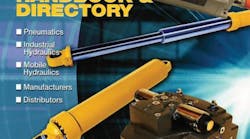Now, another 50th anniversary beckons — that of our Fluid Power Handbook & Directory, which we publish every December in odd-numbered years, and our "Designer's Guide to Fluid Power Products," which appears in every January issue. When the Fluid Power Handbook & Directory was launched in December 1955, it was an immediate hit — or so I'm told. I think I was literally in diapers back then.
Packed with technical information about fluid power system design, components, circuits, manufacturers' literature, and categorized indexes of components and suppliers, it quickly became the Bible of fluid power technology. Of course, today's publication contains updated technical, company, and product information. Plus, it's online at www.hydraulicspneumatics.com and also is available as a CD-ROM.
Our "Designer's Guide" has undergone a more dramatic evolution. It started out as a bibliography of sources of fluid power information. But Paul Rolnick, editor at the time, recently explained to me how it transformed into the useful graphical format it is today. He had been looking at a catalog of hose fittings that had a table comparing characteristics and specifications of the different products a company offered. He and other staff members then realized that this same useful format could be applied to probably any component. Since then, our Designer's Guide appears in chart format, which makes it easy to compare sizes, ratings, and specifications of one manufacturer's products offerings to another. It is available online on our website with information that we update weekly.
So what will the future bring? For one, we plan to launch our first E-book early next year. It will provide a comprehensive tutorial on the basics of fluid power technology. Every few weeks, we'll send an e-mail to interested recipients announcing the availability of the latest chapter. By clicking on a hyperlink in the e-mail, recipients will be routed to a web page where they can download the latest chapter or previous chapters they may have missed — all for free.
Most people I know professionally didn't sit down and read an instructional text on fluid power cover to cover. However, by releasing our E-book one chapter at a time every few weeks, it will be easy for recipients to learn about the technology one small dose at a time.
I'm proud to be part of continuing a legacy that started so long ago and that actually aided in the formation of the National Fluid Power Association and Fluid Power Society — each of which recently celebrated their own 50-year anniversaries. And even though the E-book is only a small part of our on-line presence, who knows — maybe 50 years from now someone will look back on our E-book as a ground-breaking concept.


